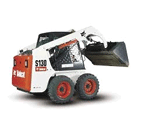
Many people use the terms "Bobcat" and "skid steer loader" interchangeably. While this is understandable, it is also not accurate. All Bobcats are skid steer loaders, but not all skid steer loaders are Bobcats. There are a number of factors that affect skid steer loader prices, first and foremost of which is the name on it. Bobcat prices tend to be more than Volvo, which tends to be more than Gehl, which is generally comparable to John Deere. Before you purchase a skid steer loader, you need to be aware of what factors may impact your Bobcat cost and whether you're actually getting a Bobcat at all!
What's In A Name?
There's a reason most people call skid steer loaders "Bobcats," regardless of actual make or model. Bobcats are the most readily identifiable, have the shortest name, and have set a high bar for skid steer loaders for decades. However, readily identifiable brands such as Volvo, Caterpillar, Gehl and John Deere also manufacture skid steer loaders that are perfectly serviceable. The biggest difference between these names is the price you can expect to pay for them and their resale value.
Bobcats tend to enjoy a higher resale value than most of their competitors, meaning the Bobcat prices will generally be higher to purchase used. Bobcat cost is generally predicated on the vehicle's condition, what attachments are included, and how many operating hours it has seen. More attachments usually means a higher price, while higher clock time translates to less expense. Average skid steer loader prices tend to vary according to location and vendor, but generally fall into a range of values that allow you to make a budget for picking out the right equipment for the job.
What To Look For In A Used Bobcat
The three most important things to consider when looking at used Bobcat prices are operational hours, hauling capacity, and overall vehicle condition. A skid steer loader intended as a backup or general utility hauler may not necessarily have to be in dealership condition, but at least should be capable of moving reliably. A loader that is intended for a wider range of jobs needs to be in better condition to get the most out of your investment. Some things to check include areas of rust, tire wear and condition, and whether the equipment shows signs of reconditioning or attempts to conceal previous damage.
The next thing to check is the size. A skid steer loader that is too big is just as bad as one that is too small. Small-frame loaders top out at around 1,750lbs, while medium-frame loaders can handle up to 2,200lbs. Large-frame loaders are generally good above 2,200lb. However, another issue to consider is whether the loader will fit where you need it to be. If you have a five-foot-wide loader and a four-foot gate, your loader is unlikely to be much help.
In the same way, the dumping height of the loader and the kinds of jobs and environments in which it will be used need to be considered. Small-frame loaders may have a dump height as low as 8', which won't do you much good if you need to get a 12' hauler. Additionally, the kind of environment you're using the loader in will dictate what kind of tires and ancillary equipment you need. For rough areas or construction sites, foam pneumatic tires are a good choice, while regular air-filled tires give a smooth ride on rough surfaces but frequently go flat.
Operational hours and the condition of the hydraulics and attachments are the last points to consider. Knowing the number of hours can help you get a lower Bobcat cost, while catching any potential problems early can save you a fortune in repair bills. It is always a good idea to take the equipment out and put it through its paces, working in as many of the anticipated conditions to which the loader will be exposed as possible. Every gear, speed, and available attachment should be tested during this process. For added security, you should also have specialized parts such as hydraulics tested by a trained professional.
Getting The Best Value For The Money
Having determined the size, condition, operational hours, and all the other factors that may raise or lower skid steer loader prices, you're ready to talk turkey. Remember when haggling that the following items increase the value:
- Low operational hours
- Good overall condition
- Attachments (the more specialized, the more expensive)
- Frame size
- Loading capacity
- Brand name (could go either way with this)
- Model year
While the following items can decrease the value:
- High operational hours
- Evidence of rust, damage, or attempts to cover up such evidence
- Loader is in poor to okay condition
- Lower loading capacity
- Few or no attachments
By understanding what your needs are and what you want in a skid steer loader, you can find a bargain anywhere in the country. However, always keep in mind that a good deal is only good if the equipment does the job after you get it off the truck and put it to work. A little due diligence up front can save a lot of time and money later.

